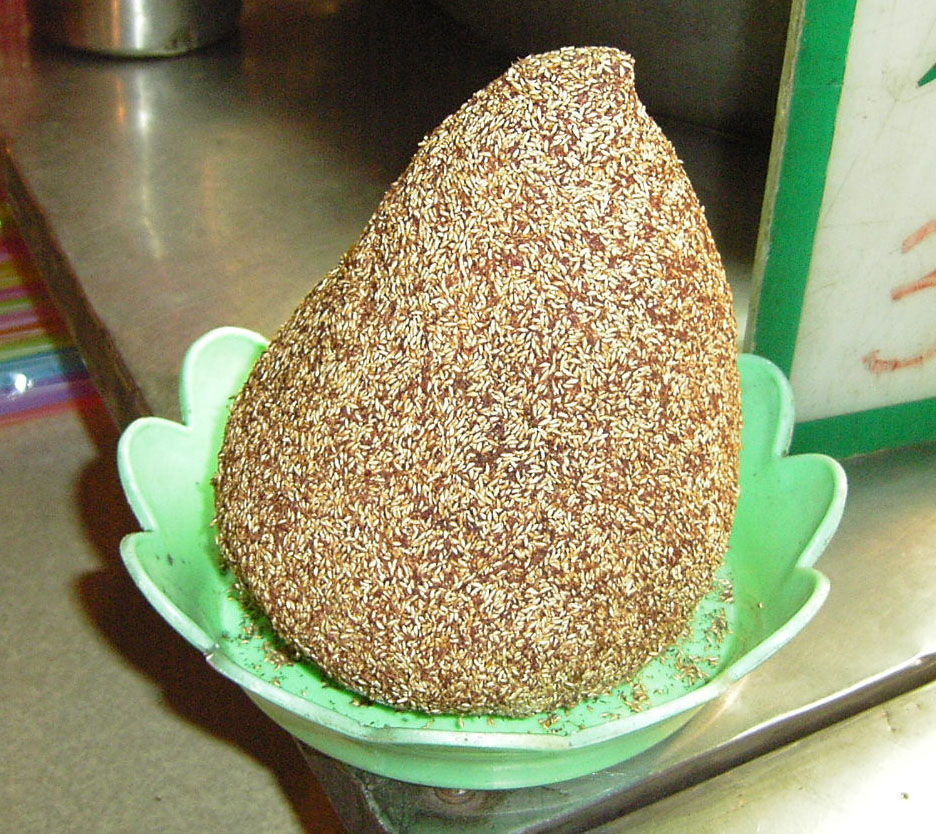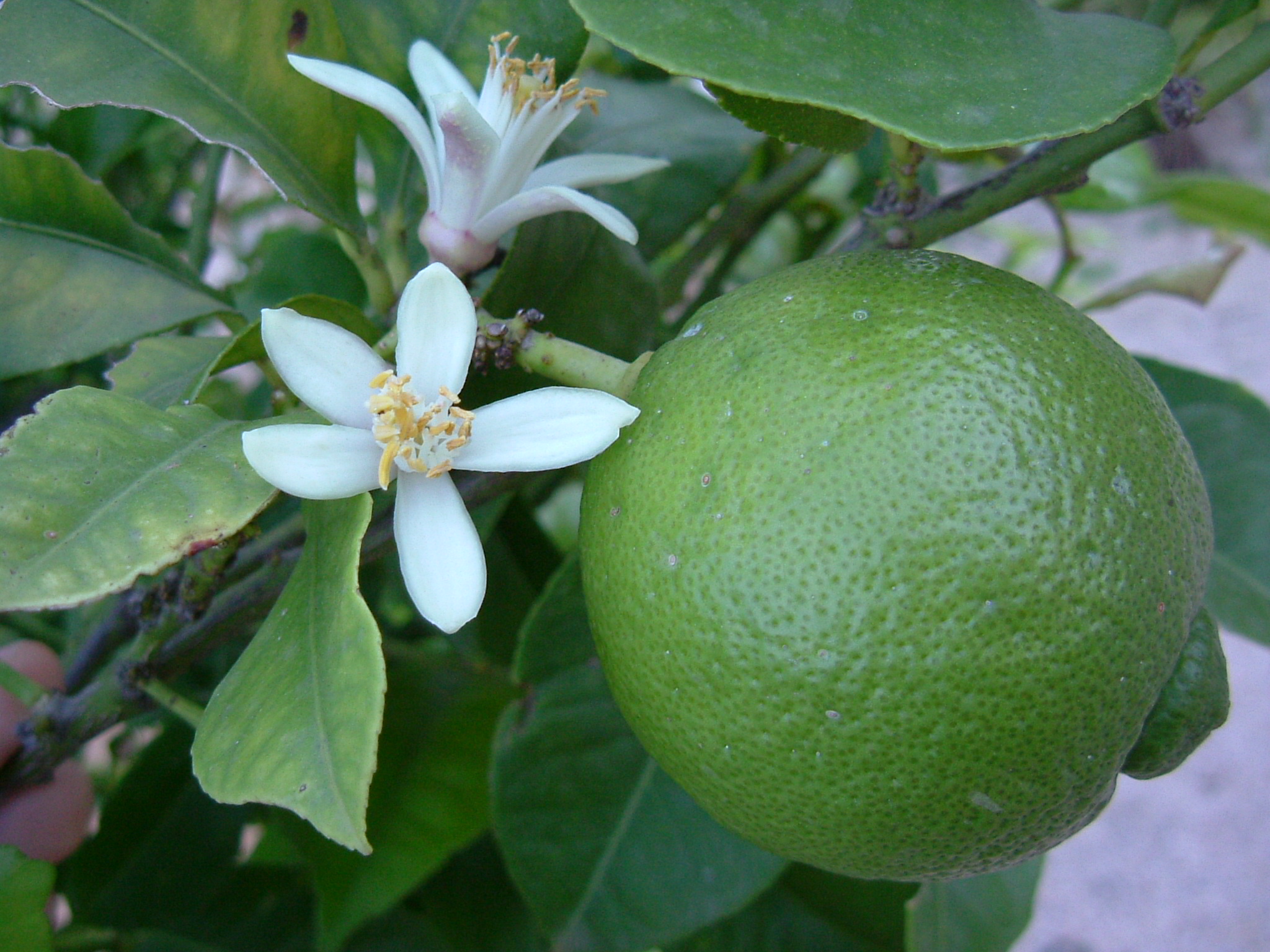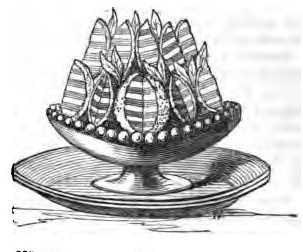|
Aiyu Jelly
Aiyu jelly (; or ; or simply ), known in Amoy Hokkien as ''ogio'' (), and as ice jelly in Singapore (), is a jelly made from the gel from the seeds of the awkeotsang creeping fig found in Taiwan and East Asian countries of the same climates and latitudes. The jelly is not commonly made or found outside of Taiwan, Malaysia, and Singapore, though it can be bought fresh in specialty stores in Japan and canned in Chinatowns. It is also used in Taiwanese cuisine. In Cantonese, it is also known as man tau long (文頭郎). It is commonly served with a slice of lime. Origin According to oral history, the plant and the jelly were named after the daughter of a Taiwanese tea businessman in the 1800s. The gelling property of the seeds was discovered by the businessman as he drank from a creek in Chiayi. He found a clear yellowish jelly in the water he was drinking and was refreshed upon trying it. Looking above the creek he noticed fruits on hanging vines. The fruits contained seeds that ... [...More Info...] [...Related Items...] OR: [Wikipedia] [Google] [Baidu] |
Lime (fruit)
A lime (from French language, French ''lime'', from Arabic ''līma'', from Persian language, Persian ''līmū'', "lemon") is a citrus fruit, which is typically round, lime (color), green in color, in diameter, and contains acidic juice vesicles. There are several species of citrus trees whose fruits are called limes, including the Key lime (''Citrus aurantiifolia''), Persian lime, kaffir lime, Makrut lime, and Citrus glauca, desert lime. Limes are a rich source of vitamin C, are sour, and are often used to accent the flavours of foods and beverages. They are grown year-round. Plants with fruit called "limes" have diverse genetic origins; limes do not form a monophyletic group. Plants known as "lime" The difficulty in identifying exactly which species of fruit are called lime in different parts of the English-speaking world (and the same problem applies to synonyms in other European languages) is increased by the botanical complexity of the citrus genus itself, to which the m ... [...More Info...] [...Related Items...] OR: [Wikipedia] [Google] [Baidu] |
Aiyu Jelly By Brappy! In Taipei
Aiyu jelly (; or ; or simply ), known in Amoy Hokkien as ''ogio'' (), and as ice jelly in Singapore (), is a jelly made from the gel from the seeds of the awkeotsang creeping fig found in Taiwan and East Asian countries of the same climates and latitudes. The jelly is not commonly made or found outside of Taiwan, Malaysia, and Singapore, though it can be bought fresh in specialty stores in Japan and canned in Chinatowns. It is also used in Taiwanese cuisine. In Cantonese, it is also known as man tau long (文頭郎). It is commonly served with a slice of lime. Origin According to oral history, the plant and the jelly were named after the daughter of a Taiwanese tea businessman in the 1800s. The gelling property of the seeds was discovered by the businessman as he drank from a creek in Chiayi. He found a clear yellowish jelly in the water he was drinking and was refreshed upon trying it. Looking above the creek he noticed fruits on hanging vines. The fruits contained seeds that ... [...More Info...] [...Related Items...] OR: [Wikipedia] [Google] [Baidu] |
Bingfen
{{Sichuan cuisine
Sichuan cuisine
Chinese desserts
''Bingfen'' (), also called ice jelly, is a Chinese dessert native to Southwest China in provinces such as Sichuan, Guizhou, and Yunnan. It is served as a bowl of iced transparent jelly, made from the seeds of the '' Nicandra physalodes'' plant, along with toppings like haw flakes and wolfberries. It is commonly sold in the summertime as a street food. References See also * Sichuan cuisine * Aiyu jelly * List of Chinese desserts * Chinese desserts Chinese desserts () are sweet foods and dishes that are served with tea, along with meals [...More Info...] [...Related Items...] OR: [Wikipedia] [Google] [Baidu] |
O-aew
''O-aew'' ( th, โอ้เอ๋ว, , , from zh, t= 薁蕘, poj=ò-giô) is a shaved ice dessert known as a local specialty of Phuket, Thailand. Introduced by Hokkien Chinese settlers, it is known after its main ingredient, a jelly made from seeds of the o-aew plant (a variety of the creeping fig, ''Ficus pumila'' var. ''awkeotsang''), an ingredient now most commonly found in Taiwan where it is known as aiyu jelly. History and preparation ''O-aew'' originated from aiyu jelly, an ingredient in Hokkien Chinese cuisine, and was introduced to Phuket by Hokkien immigrants who settled there during the boom in the tin mining industry from the mid-19th to early 20th centuries. While the jelly is found today in various locations with significant Hokkien diaspora such as Taiwan and Singapore, the variety found in Phuket was most influenced by nearby Penang. Several well-known vendors in Phuket's Old Town have sold ''o-aew'' as a family business over multiple generations. The dessert's ... [...More Info...] [...Related Items...] OR: [Wikipedia] [Google] [Baidu] |
Gelatin Dessert
Gelatin desserts (also Jelly or Jello) are desserts made with a sweetened and flavoured processed collagen product ( gelatin). This kind of dessert was first recorded as jelly by Hannah Glasse in her 18th-century book '' The Art of Cookery'', appearing in a layer of trifle. Jelly is also featured in the best selling cookbooks of English food writers Eliza Acton and Isabella Beeton in the 19th century. They can be made by combining plain gelatin with other ingredients or by using a premixed blend of gelatin with additives. Fully prepared gelatin desserts are sold in a variety of forms, ranging from large decorative shapes to individual serving cups. Popular brands of premixed gelatin include: Aeroplane Jelly in Australia, Hartley's (formerly Rowntree's) in the United Kingdom, and Jell-O from Kraft Foods and Royal from Jel Sert in North America. In the US and Canada this dessert is known by the genericized trademark "jello". History Before gelatin became widely available as ... [...More Info...] [...Related Items...] OR: [Wikipedia] [Google] [Baidu] |
Grass Jelly
Grass jelly, also known as leaf jelly or herb jelly, is a jelly-like dessert eaten in East and Southeast Asia. It is created by using Chinese mesona (a member of the mint family) and has a mild, slightly bitter taste. It is served chilled, with other toppings such as fruit, or in bubble tea or other drinks. Outside Asia, it is sold in Asian supermarkets. Nutritional value Unsweetened grass jelly contains, per 500 grams, 2.5 grams of protein and about 15 grams of carbohydrates, of which 0.5 gram is from dietary fiber. Grass jelly has no fat, vitamins, or minerals. Preparation Grass jelly is made by boiling the aged and slightly oxidized stalks and leaves of ''Platostoma palustre'' (''Mesona chinensis'') with potassium carbonate for several hours with a little starch and then cooling the liquid to a jelly-like consistency. This jelly can be cut into cubes or other forms, and then mixed with syrup to produce a drink or dessert thought to have cooling ( ''yin'') properties, which ... [...More Info...] [...Related Items...] OR: [Wikipedia] [Google] [Baidu] |
Night Markets In Taiwan
Taiwanese night markets ( zh, t=夜市, p=yèshì) are street markets in Taiwan that operate in urban or suburban areas between sunset and sunrise. A few, such as Huaxi Street Tourist Night Market (or Snake Alley), utilize purpose-built marketplaces, but most occupy either sidewalks or even entire streets that carry vehicle and pedestrian traffic by day. Some night markets in smaller side streets and alleys feature retractable roofs. Most night markets operate daily and feature a mixture of individual stalls selling clothing, consumer goods, ''xiaochi'' (similar to snacks or fast food), and specialty drinks. The atmosphere is usually crowded and noisy with hawkers shouting and fast-paced music playing over loudspeakers. Taiwanese night markets have evolved over the years from small local gatherings to noisy streets lined with vendors. These vendors must adhere to regulations placed on their activities by the Taiwanese government. History Similar markets have existed in Chinese c ... [...More Info...] [...Related Items...] OR: [Wikipedia] [Google] [Baidu] |
List Of Taiwanese Desserts And Snacks ...
This is a list of notable Taiwanese desserts and snacks. Some of these dishes are also a part of other cuisines. Taiwanese desserts and snacks * * * * * * * * * * * * * * * * See also * List of desserts * Taiwanese cuisine References {{Lists of prepared foods Taiwanese Taiwanese may refer to: * Taiwanese language, another name for Taiwanese Hokkien * Something from or related to Taiwan ( Formosa) * Taiwanese aborigines, the indigenous people of Taiwan * Han Taiwanese, the Han people of Taiwan * Taiwanese people, ... [...More Info...] [...Related Items...] OR: [Wikipedia] [Google] [Baidu] |
Cation
An ion () is an atom or molecule with a net electrical charge. The charge of an electron is considered to be negative by convention and this charge is equal and opposite to the charge of a proton, which is considered to be positive by convention. The net charge of an ion is not zero because its total number of electrons is unequal to its total number of protons. A cation is a positively charged ion with fewer electrons than protons while an anion is a negatively charged ion with more electrons than protons. Opposite electric charges are pulled towards one another by electrostatic force, so cations and anions attract each other and readily form ionic compounds. Ions consisting of only a single atom are termed atomic or monatomic ions, while two or more atoms form molecular ions or polyatomic ions. In the case of physical ionization in a fluid (gas or liquid), "ion pairs" are created by spontaneous molecule collisions, where each generated pair consists of a free electron and ... [...More Info...] [...Related Items...] OR: [Wikipedia] [Google] [Baidu] |
Valence (chemistry)
In chemistry, the valence (US spelling) or valency (British spelling) of an element is the measure of its combining capacity with other atoms when it forms chemical compounds or molecules. Description The combining capacity, or affinity of an atom of a given element is determined by the number of hydrogen atoms that it combines with. In methane, carbon has a valence of 4; in ammonia, nitrogen has a valence of 3; in water, oxygen has a valence of 2; and in hydrogen chloride, chlorine has a valence of 1. Chlorine, as it has a valence of one, can be substituted for hydrogen. Phosphorus has a valence of 5 in phosphorus pentachloride, . Valence diagrams of a compound represent the connectivity of the elements, with lines drawn between two elements, sometimes called bonds, representing a saturated valency for each element. The two tables below show some examples of different compounds, their valence diagrams, and the valences for each element of the compound. Modern definitions ... [...More Info...] [...Related Items...] OR: [Wikipedia] [Google] [Baidu] |
Pectin
Pectin ( grc, πηκτικός ': "congealed" and "curdled") is a heteropolysaccharide, a structural acid contained in the primary lamella, in the middle lamella, and in the cell walls of terrestrial plants. The principal, chemical component of pectin is galacturonic acid (a sugar acid derived from galactose) which was isolated and described by Henri Braconnot in 1825. Commercially produced pectin is a white-to-light-brown powder, produced from citrus fruits for use as an edible gelling agent, especially in jams and jellies, dessert fillings, medications, and sweets; and as a chemical stabiliser in fruit juices and milk drinks, and as a source of dietary fiber. Biology Pectin is composed of complex polysaccharides that are present in the primary cell walls of a plant, and are abundant in the green parts of terrestrial plants. Pectin is the principal component of the middle lamella, where it binds cells. Pectin is deposited by exocytosis into the cell wall via vesicles produc ... [...More Info...] [...Related Items...] OR: [Wikipedia] [Google] [Baidu] |
Thickening Agent
A thickening agent or thickener is a substance which can increase the viscosity of a liquid without substantially changing its other properties. Edible thickeners are commonly used to thicken sauces, soups, and puddings without altering their taste; thickeners are also used in paints, inks, explosives, and cosmetics. Thickeners may also improve the suspension of other ingredients or emulsions which increases the stability of the product. Thickening agents are often regulated as food additives and as cosmetics and personal hygiene product ingredients. Some thickening agents are gelling agents (gellants), forming a gel, dissolving in the liquid phase as a colloid mixture that forms a weakly cohesive internal structure. Others act as mechanical thixotropic additives with discrete particles adhering or interlocking to resist strain. Thickening agents can also be used when a medical condition such as dysphagia causes difficulty in swallowing. Thickened liquids play a vital role in ... [...More Info...] [...Related Items...] OR: [Wikipedia] [Google] [Baidu] |




.jpg)




